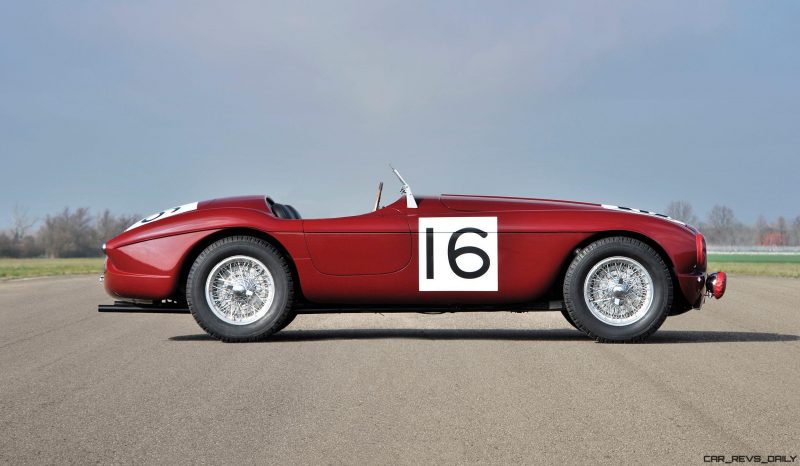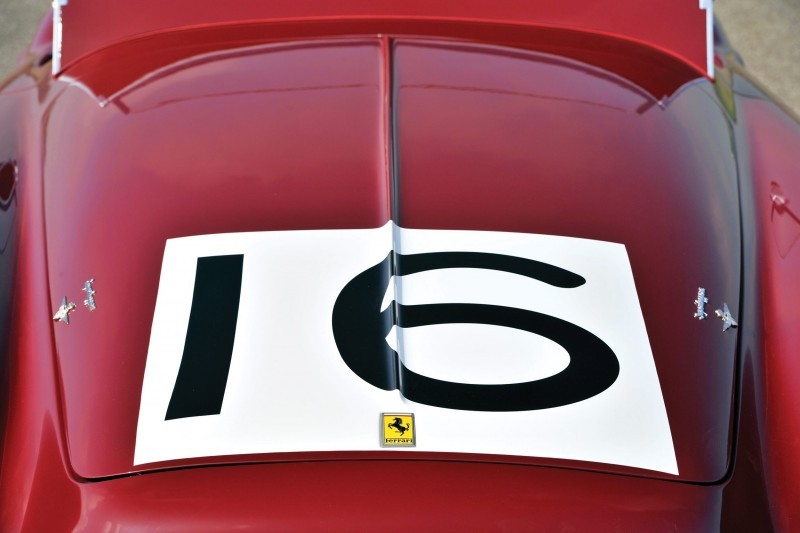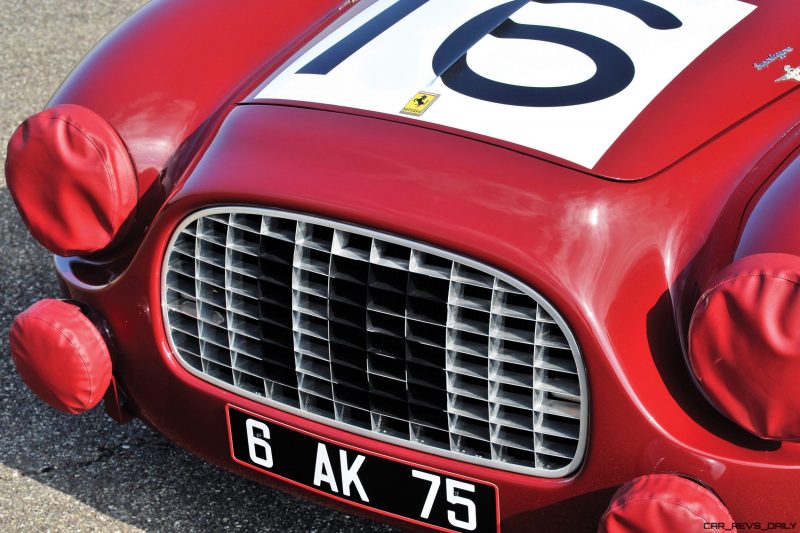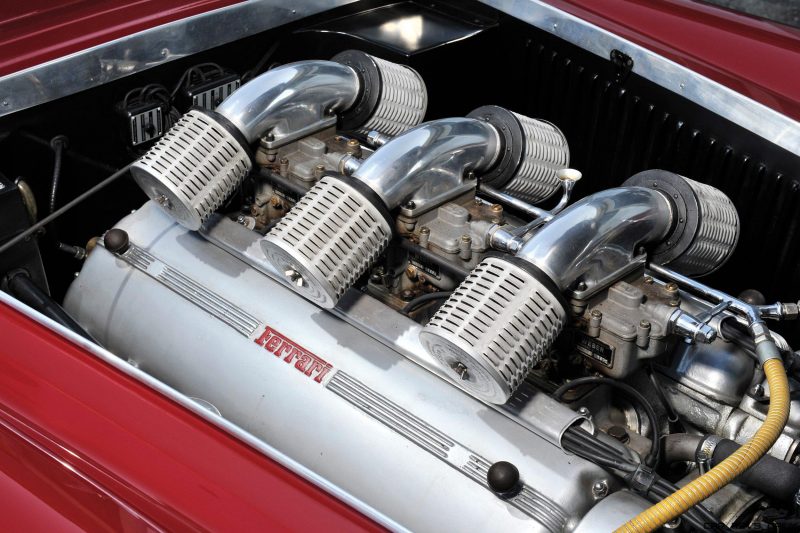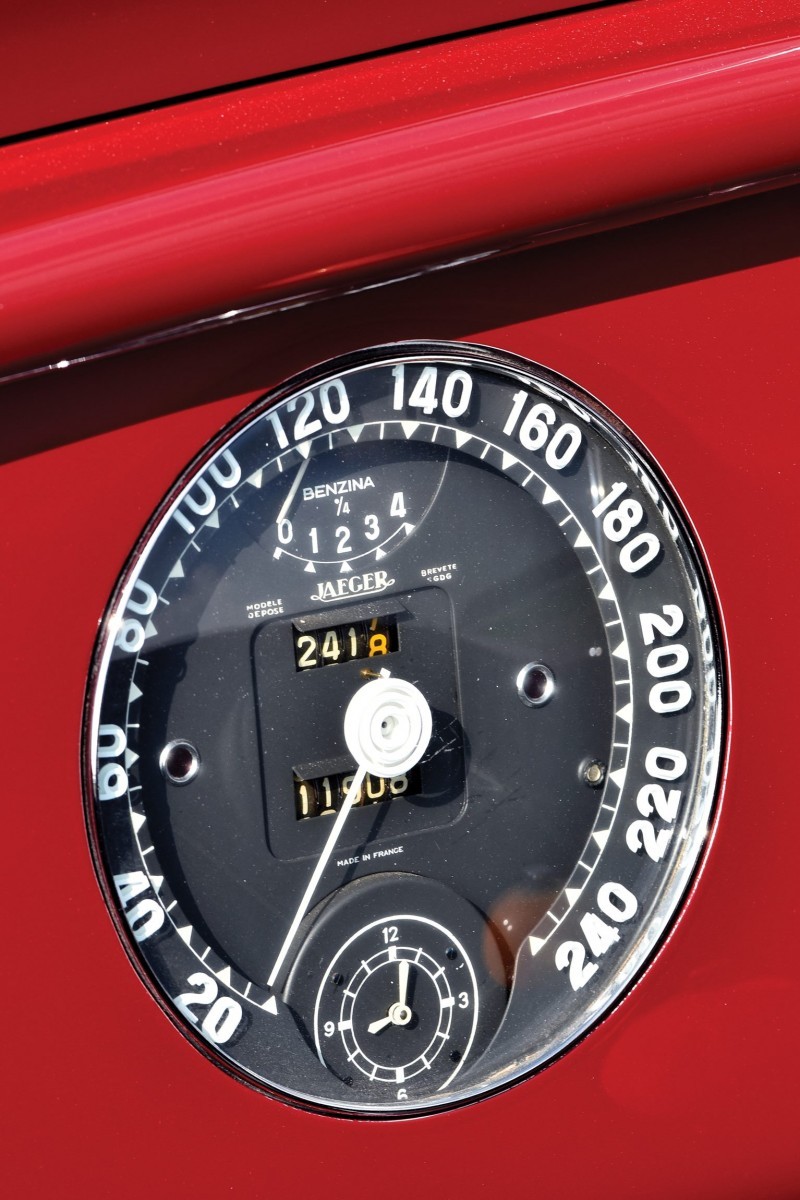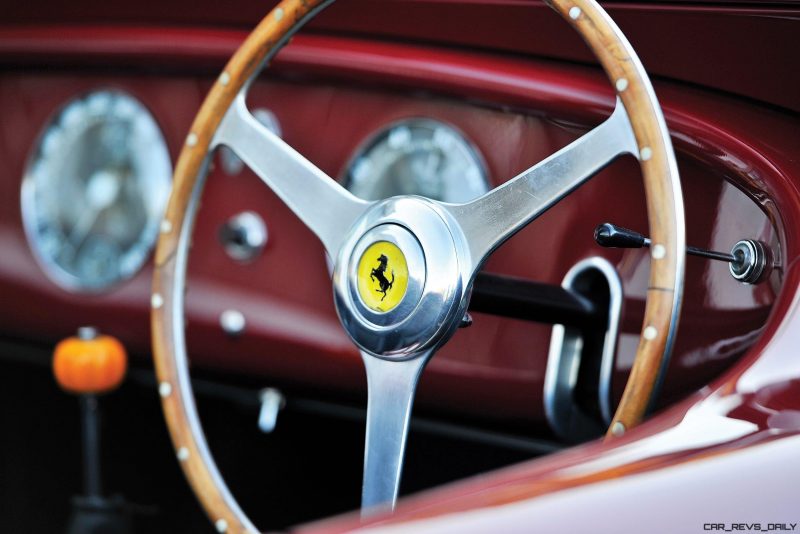How far Ferrari has come!
What started out with a genius 2.0-liter V12 engine that was ultra compact yet also super powerful. The engine roared its way to the top of the racing world by the end of the 1950s, and on to a 5-billion-dollar IPO for just a slim minority of the firm’s shares in 2015?
Now a global luxury juggernaut with brand recognition to rival Coca-Cola, and desirability up there with Apple?
Yes to all. And quite a rare display of modesty and humility from Ferrari.
It is intriguing to see how basic and workmanlike the first few cars really were. This 340 America Barchetta by Touring Superleggera is one of eight to wear bodywork by the famed carrosserie. Yet even with the finest aircraft aluminum and master craftsmen to shape each panel lovingly… the result is clearly functional over beautiful. There is elegance in the rear end panel creases, but far less so up front. Extra rally lights in the lower corners of the vehicle are mounted via underbody metal mounts — prioritizing track night vision over aero, clearly.
The structual brace between the A-pillars in body color is one example of this make-do spirit. Straight-cut, flat glass also speaks to the need to get out on the racetrack ASAP.
An adjustable rake for the windshield can be folded down or up. In its reclined position, the glass is tilted more rearward than its normal upright mount. While in fully folded mode, the glass is hinged at the bottom and makes a nice mini wind-break when folded down to meet the upper hood.
It is the legacy of this 1951 and 1952 24 Hours of Le Mans racecar that gives its every line a rose-tinged, loving hue in retrospect.
When this beauty rumbles across the block in Monaco at RM Sotheby’s May event, it will mark a high point in automotive culture. A handoff from one loving caretaker of racing icons to the next. Treat her well, sir or madam!
1951 Ferrari 340 America Barchetta by Touring (RHD)
1951 Ferrari 340 America Barchetta by Touring
- Chassis no. 0116/A
- Engine no. 004/A
- Gearbox no. 9 A
317 bhp, 4,100 cc Tipo 340 60-degree V-12 engine with three Weber 40 DCF carburettors, five-speed manual transmission, independent front suspension with transverse leaf spring, rear solid axle with semi-elliptic leaf springs, and four-wheel drum brakes. Wheelbase: 2,420 mm
- Formerly of the renowned Pierre Bardinon Collection Mas du Clos
- Entrant in the 1951 and 1952 24 Hours of Le Mans
- The third of twenty-three 340 America chassis built; the second of eight bodied by Touring
- Matching-numbers example
- Eligible for historic motoring events around the world
- A spectacular early competition Ferrari
Assembly of this 340 America Barchetta, chassis number 0116/A, began in January of 1951, with Walter Seghedoni assembling the transaxle, closely followed by assembly of the engine, which was completed in April. On 2 May, the engine’s testing was finished on the dyno, producing 317.76 brake horsepower at 6,500 rpm and 426.6 N.m at 4,000 rpm. The engine was then fitted to the completed chassis, noted on its build sheet as having a reinforced front leaf spring, and it left the factory on 7 May to be fitted with its elegant Barchetta coachwork by Carrozzeria Touring. On 14 June, the car, having returned to Ferrari, was test-driven by Mr D’Angelo.
Two days later, chassis number 0116/A was sold to its first owner, Pierre Louis-Dreyfus. A hero of World War II who had flown 81 bombing missions, he would later take over the multi-million-dollar business known today as the Louis-Dreyfus Group. In his spare time, he was an enthusiastic racing driver and sportsman, often racing under the alias of “Helde”. Mr Louis-Dreyfus was a regular entrant in the 24 Hours of Le Mans, first in 1931 in a Bugatti Type 43, with his highlight being 2nd overall in 1935 at the wheel of an Alfa Romeo 8C 2300.
The 1951 24 Hours of Le Mans was held on the 23rd and 24th of June, just a week after Mr Louis-Dreyfus took delivery of his 340 America. Nine Ferraris were entered that year, among them four of the latest 340 America, which was a pre-race favourite thanks to rumours that the car was capable of over 150 mph (then an astounding speed) along the Mulsanne Straight. Louis-Dreyfus was among the entrants, #16, and employed none other than Luigi Chinetti to run the car, with friend and Formula One ace Louis Chiron sharing driving duties. Chiron, of course, was a legend of his own, especially in Bugatti circles, having enjoyed victories at many of Europe’s most prestigious events, including the Monaco, Belgian, Italian, Spanish, and German Grand Prix, as well as the 24 Hours of Spa in 1933.
Le Mans 1951 began at 4:00 pm with 60 starters under blue skies but with the threat of rain. Chiron quickly became entangled in an intense battle with the sister 340 America of Eddie Hall, a battle so engrossing that he missed the pit-signal to refuel and ran dry on the circuit. A mechanic quickly drove out with a can of fuel and topped up the car, allowing Chiron to return to the pits as if nothing had happened. Louis-Dreyfus took over driving duties and continued, but it was not long before race director Charles Faroux appeared. Chiron admitted that he had refuelled illegally outside of the pit lane, and the car was duly black-flagged after only 29 laps. Despite the early retirement, the car showed great pace; even at the end of the 24 hours, they still held the 11th fastest lap time!
A year passed, and once more Dreyfus entered chassis number 0116/A at Le Mans. The car was again maintained by Chinetti, but now René Dreyfus (no relation to the owner) shared driving duties. Dreyfus was a well-known competitor, whose career highlights included victories at the 1930 Monaco Grand Prix and 1934 Belgian Grand Prix, as well as a 2nd overall finish at the 1935 Italian Grand Prix while co-driving with Tazio Nuvolari for the Scuderia Ferrari! The 340 America again donned #16 but this year gained some unique air scoops behind the doors, helping to ventilate the rear drum brakes.
The car qualified 15th and during the opening laps improved to 14th by the third hour. Unfortunately, the clutch began to slip, and the car fell down the order, finally retiring after five hours. A picture of the car survives, showing it in the paddock alongside Ferrari 225 S, chassis number 0152 EL, on Sunday morning after both had retired; neither shows signs of damage.
Chassis number 0116/A next appeared at the Coupes du Salon in October 1952, entered by René Marchand. It was later registered on French license plate 921 CA 40 and, in 1955, was sold to Jacques Lenglet, a resident of Romainville who traded in his previous daily driver, a Bugatti Type 57SC Atalante. During Mr Lenglet’s tenure, he re-registered the car as 9360 KM 75, a number it retained until its acquisition by a Mr Bonjean in November of 1960.
Four years later, the 340 America was acquired by the renowned Ferrari collector Pierre Bardinon for his impeccable Collection Mas du Clos. It was subsequently restored in Modena. In the early 1970s, it was sold to an Italian politician, Giuseppe Medici of Reggio Emilia, next passing to a prominent Italian collector based in Belgium, Ennio Gianaroli. Mr Gianaroli entered the car in the Mille Miglia in 1990 (#324) and 1998 (#297), as well as in such events as the FF40 meeting in 1992 and the Ferrari 50th Anniversary meets in Rome and Modena in 1997.
In the care of its most recent Italian owner, the car was entered in the Mille Miglia a further five times, as well as in the Gran Premio Nuvolari and the Coppa d’Oro delle Dolomiti. It was also presented at the Carrozzeria Touring display at the Concorso d’Eleganza Villa d’Este in Italy in 2008.
Most recently, chassis number 0116/A has been fully restored to its 1951 Le Mans configuration and will certainly continue to be welcomed at the most important historic events worldwide, including the Mille Miglia, Tour Auto, Monaco Historic Grand Prix, and, of course, the Le Mans Classic.
Photo Credits (Color): Tim Scott ©2016 Courtesy of RM Sotheby’s
Photo Credits (B&W): Courtesy of the Geoffrey Goddard Collection

Tom Burkart is the founder and managing editor of Car-Revs-Daily.com, an innovative and rapidly-expanding automotive news magazine.
He holds a Journalism JBA degree from the University of Wisconsin – Madison. Tom currently resides in Charleston, South Carolina with his two amazing dogs, Drake and Tank.
Mr. Burkart is available for all questions and concerns by email Tom(at)car-revs-daily.com.






